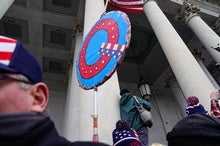 |
| January 18, 2022 |
Dear Reader,
Before they can stop new hypersonic weapons, defense systems need to track them. But picking out a threat as it moves over the Earth's surface is like detecting a single lightbulb against a background of more lightbulbs. A new system of satellite-based detectors aims to solve the problem—with help from algorithms that find the signal in the noise. |
| | Sophie Bushwick, Associate Editor, Technology
| |
 |
| |
| |
| |
| |
| |
| |
| |
| |
FROM THE STORE
 | | | |
| QUOTE OF THE DAY
 "From initial design through clinical testing and mass production, it takes four to six months to generate new batches of a variant-specific vaccine for distribution ... But experience shows that new variants can emerge and flame out on shorter timescales." Charles Schmidt, Scientific American | |
| |
FROM THE ARCHIVE
 | | | |
LATEST ISSUES
 |
| |
| Questions? Comments?  | |
| Download the Scientific American App |
| |
| |























